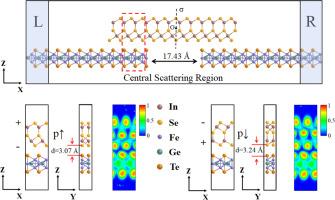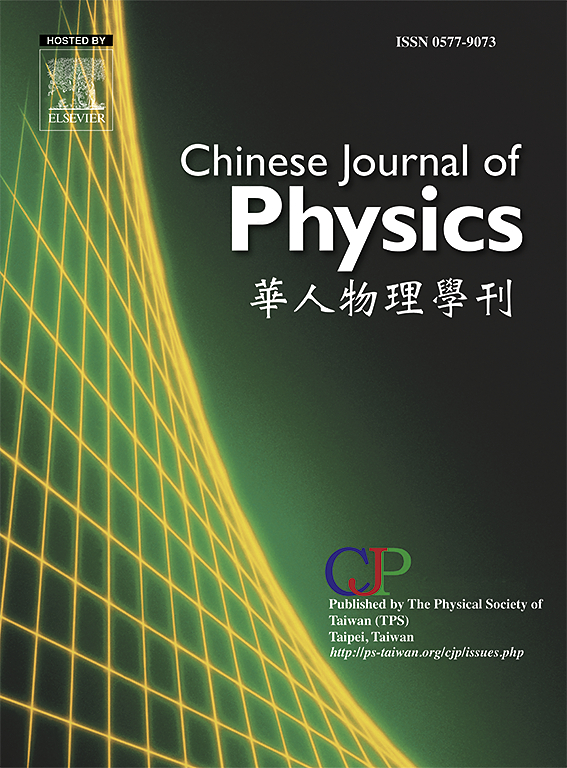Fe3GeTe2/α-In2Se3双铁结的磁电协同四态存储器
IF 4.6
2区 物理与天体物理
Q1 PHYSICS, MULTIDISCIPLINARY
引用次数: 0
摘要
本研究展示了由二维铁电α-In2Se3势垒层和铁磁Fe3GeTe2 (FGT)电极组成的双铁隧道结(Fe3GeTe2/α-In2Se3/Fe3GeTe2)。通过协同控制铁电极化方向(P↑/P↓)和磁自旋排列(平行/反平行),实现了四种不同的非挥发性电阻状态。铁电极化反转动态调节界面势垒高度,通过减少隧道效应和肖特基势垒在P ^态建立低阻通道。与P↓结构相比,该机制将电流提高了一个数量级,同时实现了近乎完美的自旋极化输运,自旋极化(SP)超过95%。此外,P↓态的最大隧穿电阻(TMR)为144%,而平行磁化态的隧穿电阻(TER)为2300%。这些结果揭示了铁电-铁磁耦合产生的协同放大效应,推动了自旋电子学和多铁质异质结构的集成,用于下一代存储和逻辑技术。本文章由计算机程序翻译,如有差异,请以英文原文为准。

Magnetoelectric synergy enabled quad-state memory in Fe3GeTe2/α-In2Se3 dual-ferroic junction
This study demonstrates a dual-ferroic tunnel junction (Fe3GeTe2/α-In2Se3/Fe3GeTe2) composed of a two-dimensional ferroelectric α-In2Se3 barrier layer and ferromagnetic Fe3GeTe2 (FGT) electrodes. Four distinct nonvolatile resistance states are achieved by synergistically controlling ferroelectric polarization direction (P↑/P↓) and magnetic spin alignment (parallel/antiparallel). Ferroelectric polarization reversal dynamically modulates the interfacial barrier height, establishing a low-resistance channel in the P↑ state via reduced tunneling and Schottky barriers. This mechanism enhances the current by one order of magnitude compared to the P↓ configuration, while achieving near-perfect spin-polarized transport with a spin polarization (SP) exceeding 95 %. Furthermore, the P↓ state exhibits a maximum tunneling magnetoresistance (TMR) of 144 %, whereas the parallel magnetization state demonstrates an exceptional tunneling electroresistance (TER) of 2300 %. These results reveal a synergistic amplification effect arising from ferroelectric-ferromagnetic coupling, advancing the integration of spintronics and multiferroic heterostructures for next-generation memory and logic technologies.
求助全文
通过发布文献求助,成功后即可免费获取论文全文。
去求助
来源期刊

Chinese Journal of Physics
物理-物理:综合
CiteScore
8.50
自引率
10.00%
发文量
361
审稿时长
44 days
期刊介绍:
The Chinese Journal of Physics publishes important advances in various branches in physics, including statistical and biophysical physics, condensed matter physics, atomic/molecular physics, optics, particle physics and nuclear physics.
The editors welcome manuscripts on:
-General Physics: Statistical and Quantum Mechanics, etc.-
Gravitation and Astrophysics-
Elementary Particles and Fields-
Nuclear Physics-
Atomic, Molecular, and Optical Physics-
Quantum Information and Quantum Computation-
Fluid Dynamics, Nonlinear Dynamics, Chaos, and Complex Networks-
Plasma and Beam Physics-
Condensed Matter: Structure, etc.-
Condensed Matter: Electronic Properties, etc.-
Polymer, Soft Matter, Biological, and Interdisciplinary Physics.
CJP publishes regular research papers, feature articles and review papers.
 求助内容:
求助内容: 应助结果提醒方式:
应助结果提醒方式:


